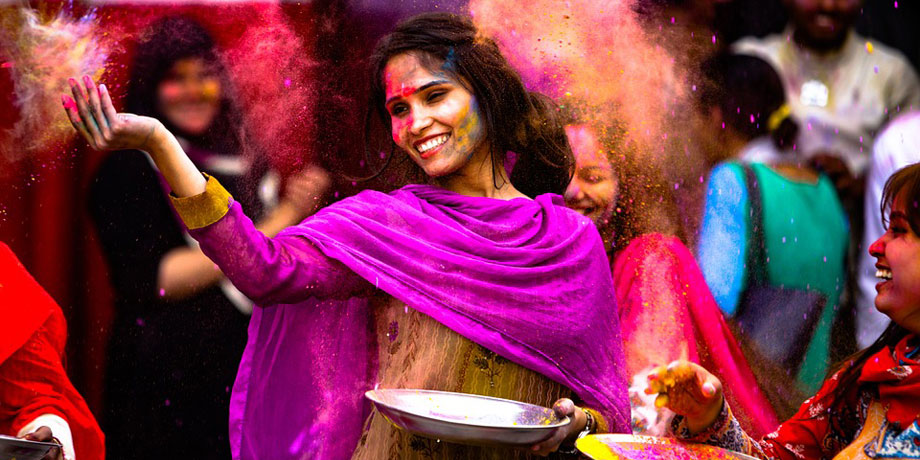
India has a rich and diverse history, dating back to the Indus Valley Civilization that flourished around 2600 BCE. It was later ruled by various dynasties and empires, including the Mughal Empire and the British Raj, before gaining independence in 1947. India has since emerged as one of the world's largest democracies and a rapidly growing economic power.
Visitors to India can expect a sensory overload, with vibrant colors, delicious spices, and bustling markets. The country is also known for its hospitality, with locals eager to share their culture and way of life with visitors.
Discovering the Multifaceted Culture of India
India is known for its rich cultural heritage, with a diverse mix of traditions and customs that vary across the country. It has a long history of art, literature, music, and dance, as well as a thriving film industry. The country is also home to many religions, including Hinduism, Islam, Christianity, Buddhism, and Sikhism, and a diverse range of linguistic and ethnic groups.
Traditional Culture in India
India has a rich and diverse cultural heritage, with a long history of art, literature, music, and dance. Some of the most notable traditional cultural elements in India include:
- Hinduism: Hinduism is the predominant religion in India and has a rich cultural heritage, including religious texts, festivals, and rituals.
- Classical Music and Dance: India has a long tradition of classical music and dance, including Hindustani music and Carnatic music, as well as classical dance forms such as Bharatanatyam and Kathak.
- Textiles: India is famous for its textiles, including hand-woven fabrics like silk, cotton, and khadi, as well as traditional clothing styles like sarees and dhotis.
Cultural Diversity in India
India is known for its diverse cultural mix, with a variety of traditions and customs that vary across the country. This diversity is reflected in the country's different regions, languages, and ethnic groups, as well as its various religions and festivals.
Religions in India:
India is home to several major religions, including:
- Hinduism: Hinduism is the predominant religion in India, with about 80% of the population following this religion.
- Islam: Islam is the second largest religion in India, with about 14% of the population following this religion.
- Christianity: Christianity is also present in India, with about 2.3% of the population following this religion.
- Buddhism: Buddhism is also present in India, with about 0.8% of the population following this religion.
- Sikhism: Sikhism is also present in India, with about 1.7% of the population following this religion.
Understanding the Geography of India – A Rich & Varied Landscape
India is the seventh largest country in the world, located in South Asia and surrounded by the Bay of Bengal, the Arabian Sea, and the Indian Ocean. It has a diverse geography, ranging from the Himalayan mountain range in the north to the tropical beaches of the south. India is also home to several major rivers, including the Ganges, the Brahmaputra, and the Indus.
India is a country that is home to a rich and varied landscape, including diverse topographical features and a range of different climates. From the majestic Himalayan Mountains to the lush tropical forests, India has something for everyone when it comes to geography. In this article, we will explore the various topographical features and climate zones of India, providing an in-depth understanding of this fascinating and complex country.
The Himalayan Mountains
The Himalayan Mountains form the northern boundary of India, and are one of the country's most famous geographical features. This range of peaks, which includes Mount Everest, the highest peak in the world, is home to some of the world's most spectacular mountain scenery. The Himalayas provide a home for a wide range of flora and fauna, and are an important source of water for the entire country.
The Indian Desert
The Indian Desert, also known as the Thar Desert, covers an area of over 200,000 square kilometers in the northwestern part of India. Despite its inhospitable environment, the Thar Desert is home to a variety of plant and animal species that have adapted to the harsh conditions. The region is also known for its unique sand dunes, and the city of Jaisalmer, located in the heart of the Thar Desert, is one of India's most popular tourist destinations.
The Deccan Plateau
The Deccan Plateau is a large plateau located in the southern part of India, and is one of the country's most fertile regions. The plateau is home to several major cities, including Hyderabad, Bangalore, and Chennai, and is an important agricultural center, producing crops such as cotton, sugarcane, and rice.
The Eastern Ghats
The Eastern Ghats are a range of hills that run parallel to the Bay of Bengal, and are home to a range of different flora and fauna species. The hills are also home to a number of important rivers, including the Godavari, which is one of India's largest rivers.
The Western Ghats
The Western Ghats are a range of hills that run parallel to the Arabian Sea, and are an important source of water for the entire country. The Western Ghats are also home to several important wildlife sanctuaries, including the Periyar Wildlife Sanctuary, which is home to tigers, elephants, and other important species.
Climate Zones
India has a diverse range of climates, ranging from tropical in the south to temperate in the north. The country can be divided into several climate zones, including the tropical wet and dry zone, the subtropical humid zone, and the temperate zone. The tropical wet and dry zone, which covers the southern and western parts of the country, experiences hot and humid summers and cool winters, while the subtropical humid zone, which covers the northern and eastern parts of the country, experiences hot and humid summers and cool to cold winters. The temperate zone, which is located in the northernmost parts of the country, experiences cool summers and cold winters.
Exploring Unusual Facts About Each Region & State Within Modern-Day India
India is a vast country that is rich in history, culture, and geography. It is also home to a diverse population that is spread across a variety of regions and states. Each region and state in India has its own unique history, culture, and geography, making it a fascinating place to explore.
North India:
- North India is known for its rich cultural heritage and is home to several historical sites, including the Taj Mahal and the Red Fort.
- The northern state of Uttarakhand is home to the Char Dham pilgrimage, which attracts millions of visitors each year.
- The northern state of Himachal Pradesh is famous for its scenic beauty and is home to several popular hill stations, including Shimla and Manali.
East India:
- East India is home to several tribal communities, including the Santhal, Oraon, and Ho tribes.
- The eastern state of Odisha is famous for its rich cultural heritage and is home to several temples and monuments, including the Sun Temple and the Lingaraj Temple.
- The eastern state of West Bengal is known for its love of food and is home to some of the best cuisine in India, including street food and sweets.
West India:
- West India is famous for its beaches and is home to several popular tourist destinations, including Goa and Mumbai.
- The western state of Gujarat is known for its rich cultural heritage and is home to several historical sites, including the Somnath Temple and the Modhera Sun Temple.
- The western state of Maharashtra is famous for its caves, including the Ajanta and Ellora caves.
South India:
- South India is famous for its scenic beauty and is home to several popular tourist destinations, including Kerala and Tamil Nadu.
- The southern state of Karnataka is known for its rich cultural heritage and is home to several historical sites, including Hampi and the Mysore Palace.
- The southern state of Andhra Pradesh is famous for its rich history and is home to several ancient temples, including the Tirumala Temple and the Sri Venkateswara Temple.
Central India:
- Central India is known for its rich cultural heritage and is home to several historical sites, including the Khajuraho Temple and the Sanchi Stupa.
- The central state of Madhya Pradesh is famous for its scenic beauty and is home to several national parks, including the Kanha National Park and the Bandhavgarh National Park.
- The central state of Chhattisgarh is known for its rich cultural heritage and is home to several historical sites, including the Dantewada Fort and the Jagdalpur Fort.
Why Visit India
India is a land of diverse cultures, religions, languages, and landscapes, making it a unique destination for travelers. It boasts a rich history, dating back to ancient civilizations, which can be seen through its stunning architecture and monuments, like the Taj Mahal. The country also offers a variety of cuisine, arts, and festivals, showcasing its diverse traditions and cultural heritage.
Visitors to India can expect a sensory overload, with vibrant colors, delicious spices, and bustling markets. The country is also known for its hospitality, with locals eager to share their culture and way of life with visitors. From the peaceful hills of Himachal Pradesh to the bustling cities of Delhi and Mumbai, travelers can expect a mix of natural beauty, rich history, and modern amenities. Whether you want to relax on a beach, go on a wildlife safari, or explore ancient temples, India has something to offer for every traveler.
Overview of safety and health considerations for travelers in India
India is a vibrant and captivating country, with a rich cultural heritage, diverse landscapes, and an abundance of natural beauty. From the bustling streets of Mumbai to the tranquil beaches of Goa, India is a destination like no other, and a visit here will be an unforgettable experience.
India is a welcoming and hospitable country, and millions of travelers visit each year.
However, as with any travel destination, it's important to be aware of safety and health considerations. While India is generally safe, it is advisable to exercise caution in busy urban areas, especially at night. Petty crime, such as pickpocketing and theft, can occur, so it's important to take precautions, such as keeping valuables secure and avoiding carrying large amounts of cash. Additionally, it's important to be aware of natural disasters, such as monsoons and earthquakes, and to take the necessary precautions.
Despite these considerations, India is a welcoming and hospitable country, and millions of travelers visit each year. With its rich history, stunning architecture, delicious cuisine, and incredible wildlife, India is a must-visit destination for travelers seeking a truly unique and memorable experience. So come and explore the wonders of India, and experience its beauty for yourself!
In conclusion, India is a diverse country that is home to a variety of regions and states, each with its own unique history, culture, and geography. From the scenic beauty of the Himalayas to the rich cultural heritage of the temples in South India, there is something for everyone to explore in this fascinating country. Whether you are interested in history, culture, or nature, India is a must-visit destination for anyone looking to experience the best of what this amazing country has to offer.



Leave a Comment